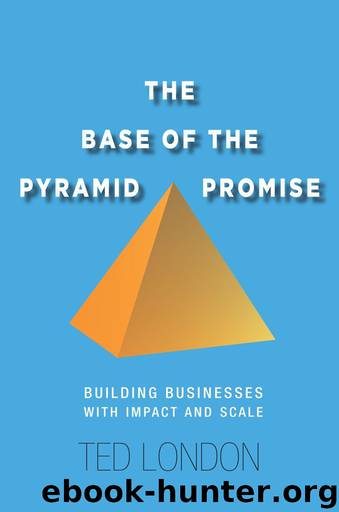The Base of the Pyramid Promise: Building Businesses with Impact and Scale by Ted London

Author:Ted London
Language: eng
Format: mobi
Publisher: Stanford University Press
Published: 2016-01-05T14:00:00+00:00
FIGURE 4.6 Sanergy’s BoP IAF
The long-term benefits, however, were much more positive. If the franchise operated successfully, the family would have a steady source of additional income. The positive unit economics and short loan payment period for each FLT, and the fact that a number of franchisees have purchased a second FLT, offer support for the viability of the model.
The children of users could also suffer short-term economic consequences, depending on how their families had previously dealt with waste disposal and sanitation. (There were less expensive, and far less sanitary, alternatives available, such as so-called flying toilets, whereby waste is deposited into a plastic bag that is then tossed into the local environment.) And while there appeared to be long-term economic benefits for user families, such as decreased medical expenses and fewer sick days, there were clear shorter-term trade-offs to be dealt with in terms of disposable income. Children of nonusers generally only saw positive changes to economic well-being. With a cleaner local environment, they and their families were generally less sick. This came at no additional cost, as they were not using the FLTs.
Our exploration of relationship well-being underscored the complexities inherent in impacts and impact assessment. A franchisee’s child might well be negatively affected in economic terms by the fact that his or her parent was tightly tied to the operation of the FLT and thereby was prevented from picking up part-time or seasonal work. The flip side of that coin was that the franchisee was closer to home on a more consistent basis and was therefore a more accessible caregiver. (Most research into child development shows that parental stimulation in the first three years of life is particularly important; franchisees were better positioned to provide that stimulation.45) Similarly, although families that incurred debt were more at risk of financial woes, especially when emergencies arose, those same families were now generally incorporated into the microcredit universe, which implied good things for their longer-term opportunities through expanded resources and networks.
Obviously, this is only a sample of the interesting findings that grew out of the application of the BoP IAF to Sanergy’s operation in Nairobi.46 The primary goal of the BoP IAF is business related, so the question then became, How can Sanergy create more value by better understanding the poverty alleviation opportunity? Although there were many positive impacts to amplify, Sanergy also sought to mitigate the negative ones. For example, Sanergy’s current business model produces financial burdens on users that can have a negative effect on the well-being of their children. These impacts on economic well-being may also discourage nonusers from converting to users or limit FLT use by current users. Our findings complemented Sanergy’s understanding of these impacts and reinforced the leadership team’s efforts to seek out donors or other external funders who would be willing to invest in providing vouchers, or similar mechanisms for minimizing negative financial impacts, to targeted existing customers and nonusers.
Similarly, the current business model imposes a financial burden on franchisees, on whom the entire operation hinges.
Download
This site does not store any files on its server. We only index and link to content provided by other sites. Please contact the content providers to delete copyright contents if any and email us, we'll remove relevant links or contents immediately.
Bad Blood by John Carreyrou(6512)
Rich Dad Poor Dad by Robert T. Kiyosaki(6349)
Principles: Life and Work by Ray Dalio(6163)
Playing to Win_ How Strategy Really Works by A.G. Lafley & Roger L. Martin(5830)
Management Strategies for the Cloud Revolution: How Cloud Computing Is Transforming Business and Why You Can't Afford to Be Left Behind by Charles Babcock(4507)
The Confidence Code by Katty Kay(4171)
Thinking in Bets by Annie Duke(4136)
American Kingpin by Nick Bilton(3731)
Delivering Happiness by Tony Hsieh(3351)
Project Animal Farm: An Accidental Journey into the Secret World of Farming and the Truth About Our Food by Sonia Faruqi(3158)
The Power of Habit by Charles Duhigg(3040)
Brotopia by Emily Chang(2978)
The Tyranny of Metrics by Jerry Z. Muller(2972)
Mastering Bitcoin: Programming the Open Blockchain by Andreas M. Antonopoulos(2964)
The Marketing Plan Handbook: Develop Big-Picture Marketing Plans for Pennies on the Dollar by Robert W. Bly(2931)
I Live in the Future & Here's How It Works by Nick Bilton(2916)
The Content Trap by Bharat Anand(2848)
Applied Empathy by Michael Ventura(2825)
Building a StoryBrand by Donald Miller(2823)
